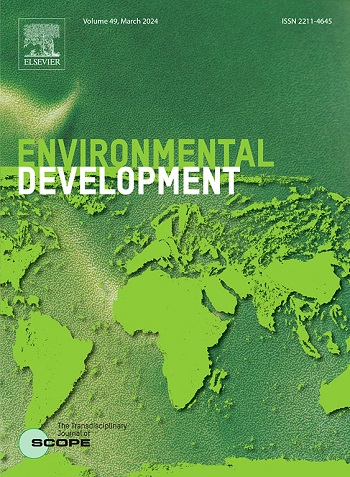用社会生态系统关系方法确定监测集水区可持续性的基本变量
IF 4.7
2区 环境科学与生态学
Q2 ENVIRONMENTAL SCIENCES
引用次数: 0
摘要
本出版物介绍了基本社会生态系统变量 (ESEV),这是一种旨在解决流域尺度社会生态系统 (SES) 项目中整合与监测难题的方法。ESEVs 被定义为 "最基本的一组关键社会-生态变量,以捕捉驱动社会-生态系统动态的关键特征、过程和相互作用的时间和空间"。值得注意的是,ESEV 与其他基本变量方法不同,因为它们是基于 SES 的 "社会 "和 "生态 "两方面之间的关系,并从涉及系统思考和社会学习的跨学科过程中衍生出来的。ESESV 方法植根于系统思维,旨在确定变量,以监测南非齐察河流域在改善 SES 可持续性方面取得的进展。ESEV 是通过与流域内跨学科 SES 项目的专家进行访谈、研讨会和调查等过程确定的。确定 ESEV 及其相关指标优先次序的标准是基于 "重要性评分 "和参与者之间的共识程度。最终确定的齐察河集水区 ESEV 包括 "与人类活动有关的土壤侵蚀"、"参与自然资源治理"、"放牧和牧场可持续性 "以及 "土地植被和状况"。此外,与会者还建议将 "水的获取"、"当地自然资源治理系统 "和 "景观中的人类福祉 "作为潜在的 ESEV。监测 ESEV 可通过混合数据源来实现,但应减少对生物物理地球观测的重视。在集水区范围内应用 ESEV 方法确保了其与环境的相关性和实用性。这项研究为监测生态系统服务和生态系统的可持续性提供了宝贵的见解,提供了适用于各种生态系统服务和生态系统景观的有效方法和流程。本文章由计算机程序翻译,如有差异,请以英文原文为准。
A relational social-ecological systems approach to determine essential variables for monitoring sustainability at a catchment level
This publication introduces Essential Social-Ecological System Variables (ESEVs), an approach aimed at addressing integration and monitoring challenges in Social-Ecological System (SES) projects at the catchment scale. ESEVs are defined as 'the minimum set of critical social-ecological variables to capture key features, processes, and interactions driving SES dynamics over time and space.' Notably, ESEVs differ from other essential variable approaches as they are based on the relational connection between the 'Social' and 'Ecological' aspects of SESs and are derived from a transdisciplinary process involving systems thinking and social learning. The ESESV approach was rooted in systems thinking to identify variables for monitoring progress towards improved SES sustainability within the Tsitsa River Catchment in South Africa. ESEVs were identified through a process involving interviews, workshops, and surveys with experts from a transdisciplinary SES project in the catchment. The criteria for prioritizing ESEVs and their associated indicators were determined based on ‘essentiality scores,’ and the degree of consensus among participants. The resulting ESEVs for the Tsitsa River Catchment included 'soil erosion related to human actions on the land,' 'participation in natural resource governance,' 'grazing and rangeland sustainability,' and 'land cover and condition.' Additionally, participants proposed 'access to water,' 'local natural resource governance system,' and 'human well-being in the landscape' as potential ESEVs. Monitoring ESEVs could be achieved through a mix of data sources, with reduced emphasis on biophysical earth observations. Applying the ESEV approach at the catchment scale ensured its contextual relevance and practicality. The study provides valuable insights for monitoring SES sustainability, offering an effective approach and process applicable to various SES landscapes.
求助全文
通过发布文献求助,成功后即可免费获取论文全文。
去求助
来源期刊

Environmental Development
Social Sciences-Geography, Planning and Development
CiteScore
8.40
自引率
1.90%
发文量
62
审稿时长
74 days
期刊介绍:
Environmental Development provides a future oriented, pro-active, authoritative source of information and learning for researchers, postgraduate students, policymakers, and managers, and bridges the gap between fundamental research and the application in management and policy practices. It stimulates the exchange and coupling of traditional scientific knowledge on the environment, with the experiential knowledge among decision makers and other stakeholders and also connects natural sciences and social and behavioral sciences. Environmental Development includes and promotes scientific work from the non-western world, and also strengthens the collaboration between the developed and developing world. Further it links environmental research to broader issues of economic and social-cultural developments, and is intended to shorten the delays between research and publication, while ensuring thorough peer review. Environmental Development also creates a forum for transnational communication, discussion and global action.
Environmental Development is open to a broad range of disciplines and authors. The journal welcomes, in particular, contributions from a younger generation of researchers, and papers expanding the frontiers of environmental sciences, pointing at new directions and innovative answers.
All submissions to Environmental Development are reviewed using the general criteria of quality, originality, precision, importance of topic and insights, clarity of exposition, which are in keeping with the journal''s aims and scope.
 求助内容:
求助内容: 应助结果提醒方式:
应助结果提醒方式:


